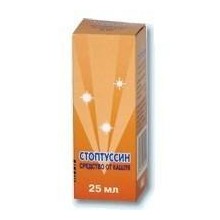



Stoptussin - combined antitussive drug with bronchodilator and expectorant action.
Pharmacodynamics
Butamirate has a peripheral local anesthetic effect on the sensory nerve endings of the bronchial mucosa, which provides an antitussive effect.
Guaifenesin increases the secretion of bronchial glands and reduces the viscosity of mucus. An increase in secretion is caused both by a direct effect on the bronchial glands — by stimulating secretion from the bronchial glands and removing acid glycoproteins from acinar cells, and by a reflex pathway, when the afferent parasympathetic fibers of the gastric mucosa are irritated and the respiratory center is inhibited. Toning upN.vagus stimulates the production of bronchial secretions. The mucus produced by the bronchial glands enhances the activity of the ciliary epithelium, as a result of which the evacuation of the mucus from the bronchi and its coughing is facilitated.
Pharmacokinetics
When ingested butamirata citrate is quickly and completely absorbed. Communication with plasma proteins is 94%. It is metabolized to form two metabolites, which also have antitussive action. Metabolites are excreted mainly by the kidneys (90%) and only a small part through the intestines. T1/2 - 6 o'clock.
Guaifenesin, when taken orally, is rapidly absorbed from the gastrointestinal tract. Communication with plasma proteins is insignificant. Guaifenesin is rapidly metabolized, with the formation of inactive metabolites, which are excreted by the kidneys. T1/2 - 1 hour.
Dry cough and irritating cough of various etiologies (including in infectious and inflammatory diseases of the upper and lower respiratory tract). Relieving cough in the pre- and postoperative period.
1 ml of drops contains:
Active substances: butamirate citrate 4 mg; guaifenesin 100 mg;
Excipients: ethanol 96% - 0.3 g; floral fragrance (alpine flowers) - 0.002 g; purified water - 0,007 g; polysorbate 80 - 0.001 g; licorice extract liquid - 0,003 g; propylene glycol - up to 1 ml.
Butamirate, Guaifenesin is marketed under different brands and generic names, and comes in different dosage forms:
| Brand name | Manufacturer | Country | Dosage form |
|---|---|---|---|
| Stoptussin | Teva | Israel | drops |
| Stoptussin | Teva | Israel | pills |
No customer reviews for the moment.
For oral use, after meal.
The appropriate number of drops is dissolved in 100 ml of liquid (water, tea, fruit juice).
Dose depending on the patient's body weight: less than 7 kg - 8 drops 3-4 times a day; 7–12 kg — 9 drops, 3–4 times a day; 12–20 kg - 14 drops 3 times a day; 20–30 kg — 14 drops, 3-4 times a day; 30–40 kg - 16 drops 3-4 times a day; 40–50 kg — 25 drops, 3 times a day; 50–70 kg - 30 drops 3 times a day; - more than 70 kg 40 drops 3 times a day.
The interval between doses should be 6–8 hours.
The use of large amounts of fluid during the course of treatment enhances its effectiveness. When used in children weighing less than 7 kg, a dose reduction is possible, due to the fact that the child does not drink all 100 ml of the prepared mixture, however, the total concentration of the drug should not be exceeded.
In the absence of a positive effect, you must consult a doctor.
From the side of the central nervous system: often - a headache.
From the organ of hearing and balance: often - dizziness.
On the part of the digestive system: often - anorexia, nausea, abdominal pain, vomiting, diarrhea; very rarely - a bitter taste in the mouth, heartburn, a feeling of heaviness in the epigastrium (pills).
On the part of the skin and subcutaneous fat: very rarely - rash, urticaria (pills, drops for oral administration), itching, hot flashes (pills).
Optional for pills
On the part of the respiratory system: very rarely - shortness of breath.
From the CCC: rarely - chest pain; very rarely - tachycardia, palpitations.
Other: very rarely - pain around the eyes.
From the kidneys and urinary tract: very rarely - urolithiasis.
Guaifenesin enhances the analgesic effect of paracetamol and acetylsalicylic acid, the effect of alcohol, sedatives, hypnotics and general anesthetics on the central nervous system, the action of muscle relaxants.
When determining the concentration of vanillyl-imindal and 5-hydroxyindolecetic acid using nitrosonaphthol as a reagent, false positive results can be obtained. Therefore, treatment with guaifenesin should be stopped 48 hours before urine collection for this test.
Stoptussin drug should not be used in the first trimester of pregnancy. If necessary, its use in the II and III trimesters should make sure that the intended benefits to the mother, exceeds the potential risk to the fetus.
There is no reliable information on the penetration of butamirate and guaifenesin into breast milk. It is necessary to stop breastfeeding for the period of use of the drug Stoptussin.
If symptoms persist, treatment should be changed.
The drug should not be prescribed for productive cough patients suffering from prolonged or chronic cough (including caused by smoking), bronchitis or pulmonary emphysema.
Influence on the ability to drive a car or perform work that requires increased speed of physical and mental reactions. The drug Stoptussin may have an adverse effect on the ability to drive vehicles and on occupations of other potentially hazardous activities that require increased concentration of attention and speed of psychomotor reactions, due to the fact that it can cause dizziness and other side effects.
Symptoms: with an overdose, signs of toxic effects of guaifenesin - drowsiness, muscle weakness, nausea, vomiting, urolithiasis - prevail.
Treatment: in case of overdose, consult a doctor. Guaifenesin does not have a specific antidote. Assign gastric lavage, reception of Activated charcoal, symptomatic therapy (support for cardiovascular, respiratory and renal functions, electrolyte balance).